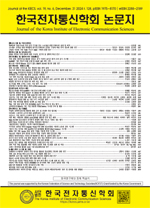매입형 영구자석 동기전동기의 최적 속도 제어
Optimal Speed Control of Interior Permanent Magnet Synchronous Motor
- 한국전자통신학회
- 한국전자통신학회 논문지
- 제19권 제6호
-
2024.121207 - 1214 (8 pages)
-
DOI : 10.13067/JKIECS.2024.19.6.1207
- 15

전동기의 제어 성능은 기준 값을 추종하는 성능과 에너지의 소비를 효율적으로 조절할 수 있는 성능 등이 있다. 제어 성능을 나타내는 제곱 형태의 비용함수를 최소화하는 제어 이득을 구하는 최적제어 기법을 사용하여 전동기를 제어하는 것은 좋은 방법이다. 전동기 최적제어의 설계를 위해서는 3차 정방행렬을 갖는 대수 리카티 방정식의 해를 구해야 하며 실시간 제어기에 적용하기에는 불편함이 존재한다. 그래서 전동기 시스템을 3가지의 단일 입출력을 갖는 1차 시스템으로 나눈다. 각각의 1차 시스템의 정상상태에서 대수 리카티 방정식의 해를 구하고 최적 이득을 각각 구했다. 설계된 최적제어 이득을 조절함에 따라 원하는 제어 성능을 얻을 수 있었다. 또한 정상상태 속도 추종 오차는 0.1[%] 이내의 최적 추종 성능을 얻을 수 있었다.
The control performance of an electric motor includes the performance of following a reference value and the performance of efficiently controlling the energy consumed. It is a good method to control the motor using an optimal control technique that finds the control gain that minimizes the quadratic form cost function representing the control performance. In order to design optimal control of an electric motor, it is necessary to find a solution to the algebraic Riccati equation with a third-order square matrix, but there is an inconvenience in applying it to a real-time controller. So the motor system is divided into three primary systems with single input and output. In each steady state, the algebraic Riccati equation of the first-order system was solved and the optimal gain was obtained respectively. The desired control performance could be obtained by adjusting the designed optimal control gain. In addition, the optimal tracking performance was achieved with a steady-state speed tracking error within 0.1[%].
Ⅰ. 서 론
Ⅱ. 최적 추종 제어
Ⅲ. IPMSM의 최적제어
Ⅳ. 시뮬레이션
Ⅴ. 결 론
References
(0)
(0)